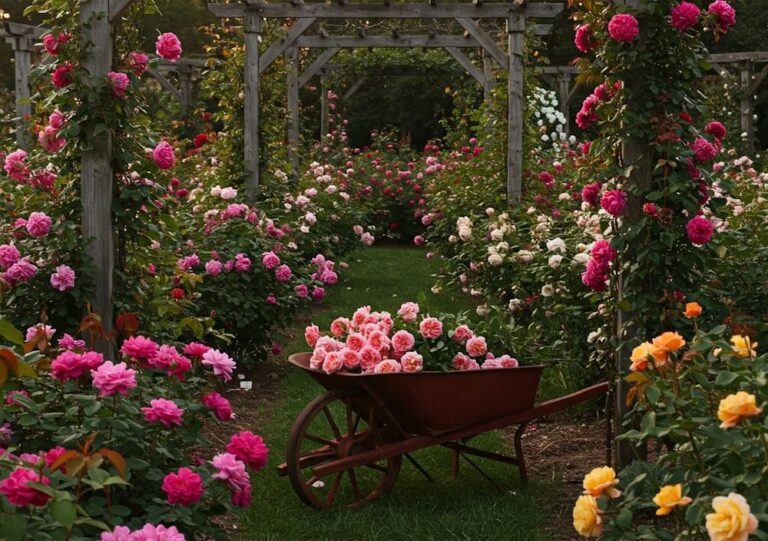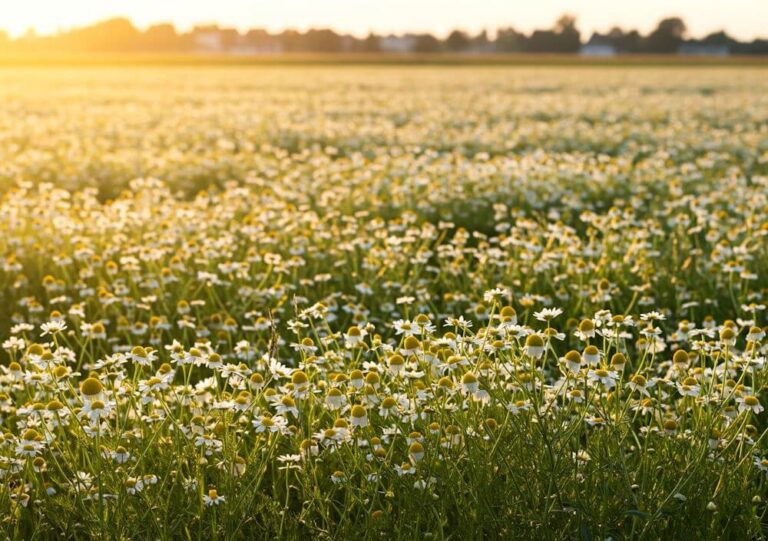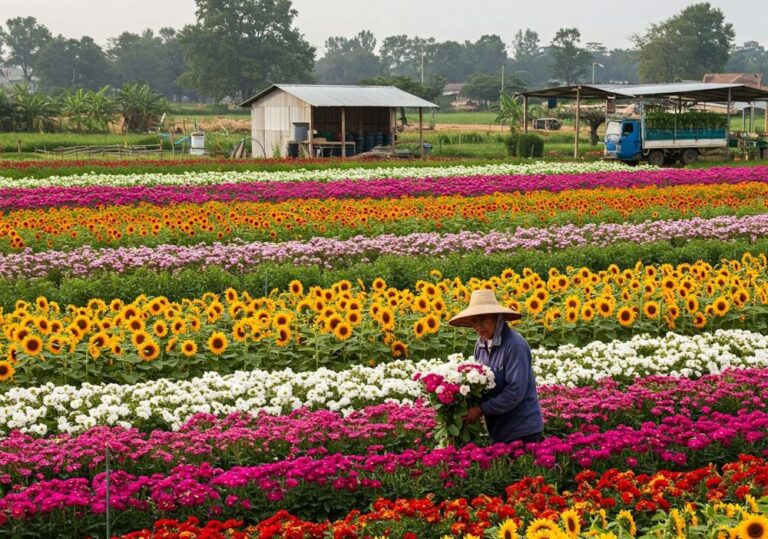Introduction to Peonies in the Flower Market
Peonies have long been celebrated for their exquisite beauty and delightful fragrance, making them a highly sought-after choice in the cut flower market. Native to Europe, North America, and Asia, these perennial plants are renowned for their lush blooms and vibrant colors, which can range from soft pastels to rich, saturated hues. Their striking appearance and enchanting scent enhance any floral arrangement, contributing to their growing popularity among consumers and florists alike.
The allure of peonies extends beyond their visual appeal; they possess a unique charm that resonates with flower enthusiasts, resulting in an increasing demand within the floral industry. As more people seek to incorporate these blooms into their celebrations and everyday life, retailers and growers have recognized the commercial potential of peonies. The trend of floral design has shifted towards incorporating seasonal flowers, and peonies, with their relatively brief blooming period, align perfectly with this aesthetic appeal, creating a sense of urgency for consumers during peak season.
Moreover, the peony’s seasonal availability typically spans from late spring to early summer, offering growers an opportunity to capitalize on this time frame. Their limited flowering season creates a captivating allure and establishes peonies as a premium product, leading to higher market prices compared to other more readily available flowers. This unique characteristic makes them an ideal choice for growers looking to enhance their cut flower sales and meet the rising demand in the floral market.
In summary, the peony stands out as a premier choice for cut flower sales, and its beauty, fragrance, and seasonal appeal create significant opportunities for growers. By tapping into the growing consumer interest in these stunning blooms, flower producers can effectively position themselves within this competitive market.
Understanding Peony Varieties
Peonies are renowned for their elegant blooms and delightful fragrance, making them a popular choice for cut flower sales. There are primarily three types of peonies—herbaceous, tree, and intersectional, each offering unique characteristics that cater to different market needs. Understanding these varieties is essential for growers aiming to optimize their floral offerings.
Herbaceous peonies are perhaps the most common type. They die back to the ground each winter, producing lush foliage and large blooms during the growing season. Bloom times for herbaceous varieties can vary, typically spanning from late spring to early summer. These peonies thrive in well-drained, loamy soil and appreciate full sun exposure. Popular varieties, such as ‘Sarah Bernhardt’ and ‘Festiva Maxima,’ provide vibrant colors and are suitable for various floral arrangements.
Tree peonies, as their name suggests, have a more woody structure that allows them to maintain foliage throughout the winter months. They tend to bloom a bit earlier than herbaceous types, often showcasing an array of colors, from soft pastels to vibrant reds. These peonies require a similar growing environment to herbaceous varieties but benefit from protection against heavy winds due to their stature. Notable varieties include ‘Shimadaijin’ and ‘Kinkaku,’ known for their large, fragrant flowers that are ideal for stunning cut arrangements.
Intersectional peonies, also known as Itoh peonies, result from a cross between herbaceous and tree types. They combine the robustness of tree peonies with the classic beauty of herbaceous peonies. Blooming in late spring to early summer, intersectional varieties offer a diverse palette of color and form. They are known for their strong stems and lush foliage, making them excellent choices for cut flower growers who want both beauty and durability. Famed hybrids like ‘Bartzella’ and ‘Cora Stubbs’ are well-regarded in the floral market.
Each peony variety comes with specific characteristics and growing conditions, enabling growers to select the most suitable types for their particular flower sales needs. By understanding the nuances of these peony varieties, growers can create a thriving business that capitalizes on the beauty and popularity of these beloved blooms.
Optimal Growing Conditions for Peonies
Peonies are well-loved for their lush blooms and delightful fragrance, but achieving optimal growth requires an understanding of the specific climatic and soil conditions they thrive in. One of the primary factors influencing the successful cultivation of peonies is sunlight. These plants prefer full sun, meaning that they should receive at least six hours of direct sunlight each day. Insufficient sunlight can lead to weak stems and sparse blooms, ultimately affecting the ability to market these flowers effectively for cut flower sales.
Another essential aspect to consider when growing peonies is the type of soil in which they are planted. Peonies grow best in well-draining, fertile soil enriched with organic matter. Loamy soil, which is a balanced mix of sand, silt, and clay, is ideal for peonies as it provides both good drainage and moisture retention. Furthermore, the pH level of the soil should ideally range between 6.0 and 7.0. A slightly acidic to neutral pH promotes the healthiest growth, allowing the plants to absorb nutrients more effectively. Soil tests are advisable to ensure pH and nutrient levels are within these parameters.
Water drainage is another critical consideration for peony cultivation. These plants are susceptible to root rot if they stand in waterlogged conditions. Therefore, ensuring that the planting area allows for proper drainage is crucial. Raised beds can be an effective solution, as they enhance soil drainage and temperature regulation. Additionally, incorporating organic materials such as compost can improve the soil structure, promoting health and vigor in peony plants. With the right conditions concerning sunlight, soil type, pH levels, and effective water drainage practices, growers can create an optimal environment that encourages robust growth and abundant flower production.
Planting and Care Techniques
Growing peonies successfully requires attention to detail, particularly concerning their planting and care techniques. A well-prepared planting site significantly enhances the vitality of these perennial flowers. Start by selecting a location that receives full sun for at least six hours daily, as peonies thrive in bright conditions, which promote robust growth and flowering.
Soil preparation is of utmost importance. Peonies prefer well-drained, fertile soil with a pH between 6.0 and 7.0. It is advisable to amend the soil with compost or well-rotted manure to improve its texture and nutrient content. Before planting, ensure that the soil is loose and devoid of any compacted areas to encourage healthy root development. Additionally, consider conducting a soil test to confirm nutrient levels and make necessary adjustments.
The proper spacing during planting is critical for the optimal growth of peonies. Each plant requires approximately three to four feet of space to allow for proper air circulation and avoid overcrowding, which can lead to fungal diseases. When planting, ensure that the eyes (buds) of the peony tubers sit about two inches beneath the soil surface. This depth is vital, as planting too deeply can hinder blooming.
Post-planting care includes regular watering, particularly during dry spells. Deep watering encourages the development of a strong root system. Fertilization should be conducted in early spring, using a balanced, slow-release fertilizer to provide essential nutrients. It is also beneficial to apply a layer of mulch around the base of the plants to retain moisture, suppress weeds, and regulate soil temperature. By combining these planting and care techniques, growers can ensure a thriving peony crop that yields captivating blooms for cut flower sales.
Pest and Disease Management
Effective management of pests and diseases is crucial for ensuring the health and productivity of peony plants, particularly for those involved in cut flower sales. Peonies can be vulnerable to a range of pests, including aphids, thrips, and nematodes, as well as various diseases such as powdery mildew, botrytis blight, and root rot. Recognizing early symptoms is vital in preventing severe infestations and crop losses.
Aphids are small, soft-bodied insects that typically cluster on new growth. Symptoms include curled or distorted leaves and the presence of sticky honeydew, which can also attract ants. Thrips may be recognized by silver streaks on leaves and flower petals, while nematode damage often manifests as stunted growth or yellowing foliage. In terms of diseases, powdery mildew appears as a white, powdery coating on leaves, whereas botrytis blight may lead to brown, mushy spots on flowers and stems. Root rot is characterized by wilting plants as a result of decaying roots, usually caused by excess moisture and poor drainage.
Preventive measures are essential for maintaining peony health. Crop rotation, proper spacing, and ensuring adequate air circulation can reduce disease incidence. Additionally, applying mulch can help deter pests and maintain soil moisture. For organic pest control, insecticidal soaps and neem oil can be effective against common insect threats. Keeping the garden clean by removing debris and infected plant material is crucial for reducing the spread of diseases.
For growers seeking chemical solutions, a variety of fungicides and insecticides are available, tailored to specific pests and diseases. When applying any chemical treatment, it is important to follow the manufacturer’s guidelines meticulously and ensure compliance with local regulations to minimize environmental impact. By implementing these strategies, peony growers can achieve healthy plants and maximize their cut flower production.
Harvesting Peonies for Maximum Quality
Harvesting peonies at the optimal time is crucial for ensuring the best quality blooms for cut flower sales. The timing of the harvest can significantly affect both the aesthetic appeal and vase life of the flowers. For peak freshness and longevity, it is advisable to cut the peonies when they are in the bud stage, specifically during the ‘soft-dome’ stage. At this point, the buds should feel slightly soft to the touch but should not have started to show any color. This stage allows the flowers to continue to open gracefully once they are in the hands of the consumer.
Utilizing proper cutting techniques is another essential element to ensure quality. It is recommended to use sharp, clean tools such as shears or a knife to make a clean cut, which minimizes damage to the plant and helps prevent the introduction of diseases. When cutting, make sure to cut at a 45-degree angle and leave at least 1-2 sets of leaves on the plant to promote future growth. It’s also beneficial to harvest peonies in the morning when temperatures are cooler, as this can help maintain their hydration levels and overall quality.
After harvest, post-handling becomes critical in preserving the health of the blooms. Immediately place cut peonies into clean, cool water to prevent any air pockets from forming in the stems. Allowing them to hydrate for several hours before arranging or packaging will enhance their vibrancy and longevity. Furthermore, removing any foliage that might be submerged in the water will help avoid bacterial growth, contributing to prolonged vase life. Attention to these details during the harvesting process is essential not only for showcasing the beauty of peonies but also for ensuring high sell-through rates in the marketplace.
Marketing Your Peonies for Cut Flower Sales
Effective marketing is essential for the successful sale of cut peonies, a flower that is renowned for its lush blooms and fragrance. One of the primary strategies involves creating visually appealing flower arrangements. Utilizing peonies’ vibrant colors and unique shapes, florists and growers can design eye-catching displays that capture potential buyers’ attention. An aesthetically pleasing arrangement not only enhances the perceived value of the flowers but also plays a key role in attracting customers at markets and exhibitions.
In today’s digital age, leveraging social media platforms can significantly boost visibility and increase sales. High-quality images of peon bouquets shared on platforms such as Instagram and Facebook can effectively showcase the beauty and versatility of these flowers. Engaging content, including behind-the-scenes videos of peony cultivation and arranging techniques, can also help in building a following. Collaborating with influencers in the floral community can further extend reach and attract a broader audience. It is crucial to include relevant hashtags and location tags to help potential buyers discover your offerings.
Understanding your target market is vital in crafting tailored marketing strategies. Identify groups that are most likely to purchase cut peonies, such as brides-to-be, event planners, and local florists. Building relationships with these stakeholders can enhance your market presence. For example, offering a special discount for bulk orders or providing complimentary consultations on floral arrangements can attract local florists and wedding planners. Constructing a strong network will not only facilitate sales but also foster a community around your business, leading to referrals and repeat customers.
Additionally, participating in local farmers’ markets or floral fairs provides excellent opportunities to introduce your peonies to the public. Direct interaction allows you to share your passion for these flowers and educate potential customers on their care and uses in various arrangements.
Seasonal Considerations for Peony Sales
Understanding the seasonal dynamics of peony sales is vital for florists and growers aiming to optimize their profitability. Peonies typically bloom between late spring and early summer, with peak sales occurring from late May to early June. This period aligns with major holidays such as Mother’s Day and weddings, significantly driving consumer demand. During this time, the fresh, vibrant blooms appeal to customers looking to purchase flowers for celebrations, special events, and personal enjoyment.
To successfully navigate the fluctuating demand for peonies, it is essential for growers to plan their planting and harvesting schedules meticulously. The timing of planting, as well as environmental factors such as temperature and rainfall, can greatly influence flower development and availability. By using season-extension techniques such as planting in cooler locations or employing shade cloth, growers can harvest their peonies earlier or later than the typical peak, catering to off-peak consumer interests and thus extending the selling season.
Moreover, diversifying offerings can significantly enhance sales during periods of lower demand. For example, integrating peonies into mixed bouquets with complementary flowers can provide consumers with a broader selection, thus attracting varied clientele. Another strategy is to promote peony subscriptions or pre-sales, allowing customers to reserve their favorite blooms ahead of time. This not only secures sales during off-peak times but also helps manage inventory levels effectively.
In summary, a keen awareness of the seasonal trends in peony sales, along with strategic planning and diversification of products, can significantly enhance profitability for floral growers and retailers alike. By making informed decisions regarding planting schedules and inventory management, the potential for extending the peony selling season becomes a tangible opportunity.
Conclusion and Future Trends in Peony Cultivation
In summary, the guide has provided comprehensive insights into the essential aspects of growing peonies for cut flower sales. Emphasizing their aesthetic appeal and commercial value, peonies remain a popular choice among consumers. With a focus on cultivation techniques, variety selection, and post-harvest handling, growers can enhance their productivity and meet the demand for these stunning blooms.
Looking forward, emerging market trends indicate a growing consumer preference for sustainably sourced products. This trend compels peony growers to adopt environmentally friendly farming practices. Utilizing organic fertilizers, implementing integrated pest management strategies, and conserving water resources are vital steps towards establishing a sustainable cultivation framework. By prioritizing sustainability, growers not only align themselves with market expectations but also contribute positively to the environment.
Additionally, advancements in technology offer opportunities for innovation in peony cultivation. High-tech solutions, such as precision agriculture tools, can help monitor soil health and optimize growth conditions. Implementing data-driven farming practices will enable growers to make informed decisions that enhance yield quality, ultimately catering to the evolving preferences of flower buyers.
Moreover, exploring unique varieties and hybrids presents another avenue for growers to distinguish themselves in the market. The emerging popularity of unconventional peony colors and shapes allows for a fresh approach to flower arrangements, appealing to designers and consumers alike. By keeping abreast of trends and embracing novel cultivars, growers can further capitalize on the flourishing cut flower market.
Ultimately, the future of peony cultivation thrives on embracing sustainable practices, leveraging technology, and exploring innovative varieties. As consumer preferences continue to evolve, adapting to these trends will be crucial for success in the cut flower industry.





